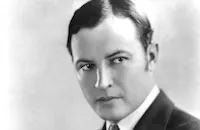The Rest Cure
Cast & Crew
Crane Wilbur
Reginald Denny
Esther Ralston
Eleanor Hunt
Vince Barnett
Claudia Dell
Film Details
Technical Specs

Synopsis
Ex-racketeer Americans Dan Linton and Spike Connover hide out in Paris from their enemies. At a cafe, they charm Mrs. Louise Rillette and Naomi until interrupted by Perrelli, a rival gangster who appears to be carrying a machine gun. Louise then suggests that Dan and Spike volunteer for the Foreign Legion for a rest cure and go to Morocco. While on their way, Dan and Spike get involved with the misconduct of Captain Henri Rillette. In the legion, Dan and Spike generally misbehave, and Dan interrupts Spike's date with Honey Evans, an exotic cabaret performer, causing a fight between them which results in a sentence of six months hard labor in a prison camp for them. Later, Dan and Spike are reunited and save Louise, Naomi, and the general's wife from being kidnapped by Arab brigands led by Abdul Ben Abou and Ali. When their secure camp is besieged, Dan and Spike lead the legionnaires to victory and are pardoned. Dan and Naomi then swear their love.

Director

Crane Wilbur
Cast

Reginald Denny

Esther Ralston
Eleanor Hunt

Vince Barnett

Claudia Dell

Robert Frazer
Rudolph Amendt
Francisco Maran

Merrill Mccormick
Manuel Peluffo
John Reinhardt

Crane Wilbur
Grace Cunard
Lou Hicks
Charles Mayer
Frank Hoyt
Crew

Film Details
Technical Specs

Quotes
Trivia
Notes
This film was also reviewed as Rest Cure. Most sources list the film as a Regal Production or a Regal-Pacific film; however, Screen Achievements Bulletin and a Film Daily Year Book ad list the film as a Condor film. George Hirliman Enterprises controlled Regal, Pacific and Condor. A Spanish-language version, De la sartén al fuego, which was shot simultaneously with the English version, was produced by Metropolitan Pictures Corp., a company set up by Hirliman to produce Spanish versions of some of his films. A Hollywood Reporter news item in February 1936 states that Hirliman had cut the film considerably. The English version was screened in New York on 3 and June 4, 1937 at a length of 56 minutes under the title We're in the Legion Now, and May have been cut from its original December 1936 release. Motion Picture Herald release charts in July 1936 list the release date as January 16, 1937 at a length of 55 1/2 minutes, although January 1937 release charts give a revised release date of December 13, 1936 at a length of 64 minutes. The June 1937 Variety review does not list John Reinhardt (director of the Spanish version of this film) as "Ringleader," but includes Charles Mayer as "Recruit ringleader." The same review calls Claudia Dell's character "Yvonne Cartier." The review describes a scene in which "a bomb concealed in a canteen is tossed around till it finally blows up, killing hundreds of enemy tribesmen," although it is unclear at what point this scene appears in the film. According to a Hollywood Reporter news item on October 10, 1935, Anita Page and Dorothy Sebastian were given screen tests for roles in this film. Sebastian is listed in the cast list in a Hollywood Reporter news item the following day, but she does not appear in the film, and Page's participation has not been confirmed. An ad in Hollywood Reporter on February 18, 1936 states that Rest Cure was the "first all-color Regal production." Hollywood Reporter erroneously states that The Rest Cure was the first American independent feature made in color. The Variety review states that although this film's color process was called "Magnacolor" on the screen, company credits claim the film was shot in Hirlicolor. Hollywood Reporter states the color process used was a modified version of Magnacolor. According to Variety, the desert and native village shots in the film were taken from newsreel stock footage.












